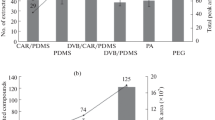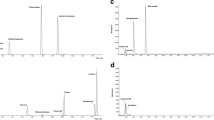Abstract
The analysis of volatile organic compounds in samples of biological fluids characterized by complex matrices is highly challenging. This paper presents a comparison of the results obtained in this field using three solvent-free techniques: thin-layer headspace with autogenous generation of liquid sorbent (TLHS) and membrane separation of the trace substances (pervaporation, PV), both of which are coupled to direct aqueous injection gas chromatography–electron capture detection (TLHS–DAI–GC–ECD and PV–DAI–GC–ECD), as well as conventional static headspace analysis followed by GC analysis with ECD detection (HS–GC–ECD). Basic validation parameters of the HS–GC–ECD, TLHS–DAI–GC–ECD and PV–DAI–GC–ECD procedures were calculated for water and urine samples. The calibration curves for all procedures were linear within the concentration range examined. The intermediate precisions of the procedures were good and reached about 10% (for all analytes) for HS–GC–ECD and TLHS–DAI–GC–ECD. The poorest results were obtained for PV–DAI–GC–ECD: about 20% for all analytes. The lowest method detection limits were obtained for the TLHS–DAI–GC–ECD procedure: below 0.0022 μg/L for all analytes. The enrichment factors did not differ significantly between water and urine samples, indicating little or no matrix effect in all procedures.




Similar content being viewed by others
References
Giardino NJ, Andelman J (1996) J Expo Anal Environ Epidemiol 6:413–423
Tancrede M, Yanagisawa Y, Wilson R (1992) Atmos Environ 26A:1103–1111
Dodds L, King W, Woolcott Ch, Pole J (1999) Epidemiology 10:233–237
Polkowska Ż, Namieśnik J, Czerwiński J, Zygmunt B (1996) Int J Food Sci Technol 31:378–395
Ukai H, Inui S, Takada S, Dendo J, Ogawa J, Isobe K, Ashida T, Tamura M, Tabuki K, Ikeda M (1997) Int Arch Occup Environ Health 70:385–392
Chao Ch Y, Chan GY (2001) Atmos Environ 35:5895–5913
Polkowska Ż, Górecki T, Namieśnik J (2001) Am Clin Lab 20:38–43
Aggazzotti G, Fantuzzi G, Righi E, Predieri G (1998) Sci Total Environ 217:155–163
Aggazzotti G, Fantuzzi G, Righi E, Predieri G (1995) J Chromatogr A 710:181–190
Lindstrom AB, Pleil JD, Berkoff DC (1997) Environ Health Perspect 105:636–642
Pohanish RP(eds)(2002) Sittig’s handbook of toxic and hazardous chemicals and carcinogens. Noyes, Norwich, UK
Batterman S, Zhang L, Wang S, Franzblau A (2002) Sci Total Environ 284:237–247
Wight JM, Schwartz J, Dockery DW (2003) Occup Environ Med 60:173–180
Kuráň P, Soják L (1996) J Chromatogr A 733:119–141
Ketola RA, Virkki VT, Ojala M, Komppa V, Kotiaho T (1997) Talanta 44:373–382
Polkowska Ż, Kozłowska K, Namieśnik J, Przyjazny A (2004) Crit Rev Anal Chem 34:105–119
Dewulf J, van Langenhove H (2002) Trends Anal Chem 21:637–646
Furuki K, Ukai H, Okamoto S, Takada S, Kawai T, Miyama YK, Mitsuyoshi K, Zhang ZW, Higashikawa K, Ikeda M (2000) Int Arch Occup Environ Health 73:221–227
Namieśnik J, Wardencki W (2000) J High Res Chromatogr 23:297–303
Wardencki W, Namieśnik J (2002) Pol J Environ Stud 11:185–187
Nakahama T, Fukuhara M, Inouye Y (1997) J Toxicol Environ Health 43:280–284
Imbriani M, Niu Q, Negri S, Ghittori S (2001) Ind Health 39:225–230
Pierce CH, Chen Y, Dills RL, Kalman DA, Morgan MS (2002) Toxicol Lett 129:65–76
Polkowska Ż, Górecki T, Namieśnik J (2001) Am Clin Lab 9:38–43
Polkowska Ż, Kozłowska K, Górecki T, Namieśnik J (2003) Chemosphere 53:899–909
Polkowska Ż, Kozłowski E, Górecki T, Namieśnik J (1999) Toxicol Environ Chem 68:1–11
Selecki A, Gawroński R (eds)(1992) Permeation methods. In: Fundamentals of designing selected mixture separation processes (in Polish). WNT, Warszawa
Kujawski W, Kerres J, Roszak R (2003) J Membr Sci 218:211–218
Kujawski W (2000) Sep Sci Technol 35:89–108
Jakubowska N, Kujawski W, Polkowska Ż, Namieśnik J (2007) Int J Environ Anal Chem (in press)
Author information
Authors and Affiliations
Corresponding author
Rights and permissions
About this article
Cite this article
Jakubowska, N., Polkowska, Ż., Kujawski, W. et al. A comparison of three solvent-free techniques coupled with gas chromatography for determining trihalomethanes in urine samples. Anal Bioanal Chem 388, 691–698 (2007). https://doi.org/10.1007/s00216-007-1259-2
Received:
Revised:
Accepted:
Published:
Issue Date:
DOI: https://doi.org/10.1007/s00216-007-1259-2




